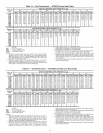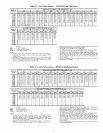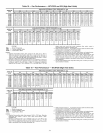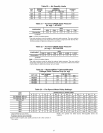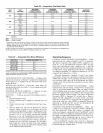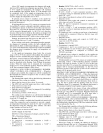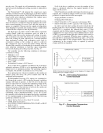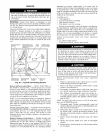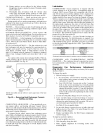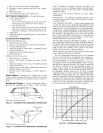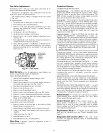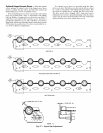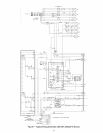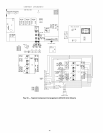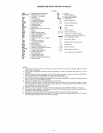
10. Ensure surfaces are not allowed to &y before rinsing.
Reapplying cleaner as needed to ensure 10-minute satura-
tion is achieved.
11. Thoroughly rinse _dl surfaces with low velocity clean
water using downward rinsing motion of water spray
nozzle. Protect tins from &_mage from the spray nozzle.
CONDENSATE DRAIN- Check and clean each year at
sttut of cooling season. In wintel, keep &ains and traps dry.
During periods of low outdoor temperatures, add anti-freeze
solution to the drain to prevent freeze up. Follow _dl precau-
tions on anti-freeze labeling.
FILTERS -- Clean or replace at start of each heating and cool-
ing season, or more often if operating conditions require. Refer
to Table 1 for type and size.
OUTDOOR-AIR INLET SCREENS -- Clean screens with
steam or hot water and a mild detergent. Do not use throwaway
filteL'sin place of screens. See Table 1 for quantity and size.
MAIN BURNER -- At the beginning of each heating season,
inspect for deterioration or blockage due to corrosion or other
causes. Observe the main burner flames. Refer to Main Burn-
eLssection on 43.
FLUE GAS PASSAGEWAYS -- The flue collector box and
heat exchanger cells may be inspected by removing heat ex-
changer access panel (see Fig. 4 and 5), flue box cover, and
main burner assembly. Refer to Main Burners section on
page 43 for burner removal sequence. If cleaning is required,
remove heat exchanger baffles and clean tubes with a wire
brush.
Use caution with ceramic heat exchanger baffles. When in-
st_dling retaining clip, be sure the center leg of the clip extends
inward toward baffle. See Fig. 49.
CERAMIC
BAFFLE
CLIP_
/
HEAT EXCHANGER
TUBES
NOTE:One baffle and clip will be in each upper tube of the heat
exchanger.
Fig. 49 -- Removing Heat Exchanger Ceramic
Baffles and Clips
COMBUSTION-AIR BLOWER -- Clean periodically to as-
sure proper airflow and heating efficiency. Inspect blower
wheel evely fall and periodically during heating season. For the
fiLst heating season, inspect blower wheel bi-monthly to deter-
mine proper cleaning frequency.
To inspect blower wheel, remove heat exchanger access
panel. Shine a flashlight into opening to inspect wheel. If clean-
ing is required, remove motor and wheel assembly by remov-
ing screws holding motor mounting plate to top of combustion
fan housing. The motor and wheel assembly will slide up and
out of the fan housing. Remove the blower wheel from the mo-
tor shaft and clean with a detergent or solvent. Replace motor
and wheel assembly.
Lubrication
COMPRESSORS- Each compressor is ch_uged with the
correct amount of oil at the factory. Conventional white oil
(Sontext 200LT) is used. White oil is compatible with 3GS oil,
and 3GS oil may be used if the addition of oil is required. See
compressor nameplate for origimd oil charge. A complete re-
ch_uge should be four ounces less than the origimd oil charge.
When a compressor is exchanged in the field it is possible that
a major portion of the oil from the replaced compressor may
still be in the system. While this will not affect the reliability of
the replacement compressor, the extra oil will add rotor drag
and increase power usage. To remove this excess oil, an access
valve may be added to the lower portion of the suction line at
the inlet of the compressol: The compressor should then be mn
for 10 minutes, shut down, and the access valve opened until
no oil flows. This should be repeated twice to make sure the
proper oil level has been achieved.
FAN SHAFT BEARINGS -- For size 016 units, bearings are
permanently lubricated. No field lubrication is required. For
size 020-028 units, lubricate bearings at least every 6 months
with suitable bearing grease. Extended grease line is provided
for far side fan bearing (opposite drive side). Typical lubricants
are given below:
MANUFACTURER LUBRICANT
Texaco Regal AFB-2*
Mobil Mobilplex EP No. 1
Sunoco Prestige 42
Texaco Multifak 2
*Preferred lubricant because it contains rust and oxidation inhibitors.
CONDENSER AND EVAPORATOR-FAN MOTOR
BEARINGS -- The condenser-fan and evaporator-fan motors
have permanently sealed bearings, so no field lubrication is
necessaq.
Evaporator Fan Performance Adjustment
(Fig. 50-52) -- Fan motor pulleys are factory set for speed
shown in Table 1.
To change fan speeds:
1. Shut off unit power supply.
2. a. Size 016 Only: Loosen belt by loosening carriage
nuts holding motor mount assembly to fan scroll
side plates (A and B).
b. Size 020-028 Only: Loosen nuts on the 2 carriage
bolts in the motor mounting base. Install jacking
bolt and plate under motor base (bolt and plate are
shipped in installer's packet). Using bolt and plate,
raise motor to top of slide and remove belt. Secure
motor in this position by tightening the nuts on the
carriage bolts.
3. Loosen movable-pulley flange setscrew (see Fig. 50).
4. Screw movable flange toward fixed flange to increase
speed and away from fixed flange to decrease speed. In-
creasing fan speed increases load on motor Do not ex-
ceed maximum speed specified in Table 1.
See Table 20 for air quantity limits.
5. Set movable flange at netuest keyway of pulley hub and
tighten setscrew. (See Table 1 for speed change for each
full turn of pulley flange.)
6. Replace and tighten belts. See Belt Tension Adjustment
section on page 42.
To align fan and motor pulleys:
1. Loosen fan pulley setscrews.
2. Slide fan pulley _dong fan shaft.
3. Make angular alignment by loosening motor from
mounting plate.
4O



